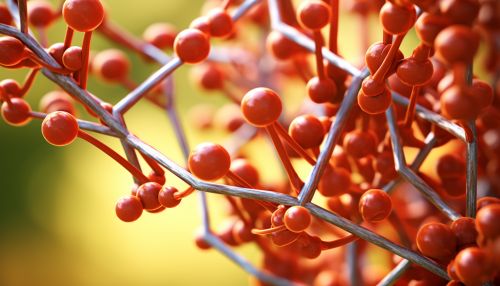Auxin
Introduction
Auxin is a type of plant hormone that plays a crucial role in coordinating many growth and behavioral processes in a plant's life cycle. These include cell division, elongation, and differentiation, as well as responses to light and gravity.
History of Discovery
The discovery of auxin dates back to the late 19th century when Charles Darwin and his son Francis conducted experiments on phototropism - the growth of organisms in response to light. They observed that light sensed by the tip of a young shoot was somehow transmitted to lower parts, causing the shoot to bend. This led to the hypothesis that some form of signaling molecule was involved. The term "auxin" was later coined by Fritz Went, a Dutch botanist, in the 1930s, from the Greek word "auxein" which means "to grow".
Chemical Structure and Types
Auxins are primarily indole-based compounds. The most common and naturally occurring auxin is Indole-3-acetic acid (IAA). Other synthetic auxins such as 2,4-Dichlorophenoxyacetic acid (2,4-D) and Naphthaleneacetic acid (NAA) are also widely used in agriculture and horticulture.


Biosynthesis and Metabolism
Auxins are synthesized in the plant cells from the amino acid tryptophan. The biosynthesis involves several enzymatic reactions, including the conversion of tryptophan to indole-3-pyruvic acid (IPA) by the enzyme TAA1 (TRYPTOPHAN AMINOTRANSFERASE OF ARABIDOPSIS 1). IPA is then converted to IAA by the YUCCA family of flavin-containing monooxygenases.
Transport
Auxin transport is a key aspect of auxin function and is unique among plant hormones. It is transported in a polar manner, from the apical regions of the plant towards the base. This polar transport is facilitated by a group of plasma membrane proteins known as PIN-FORMED (PIN) proteins.
Functions
Auxin has a wide range of functions in plants. It regulates cell elongation, controls the cell cycle, and influences differentiation and development of tissues and organs. It also plays a vital role in phototropism and gravitropism, guiding plant growth in response to light and gravity respectively.
Role in Plant Development
Auxin plays a crucial role in various stages of plant development. It is involved in embryogenesis, root and shoot formation, vascular tissue differentiation, and fruit development. It also regulates the formation of lateral and adventitious roots, and is involved in the process of apical dominance, where the main central stem of the plant is dominant over other side stems.
Agricultural Applications
Auxins have been widely used in agriculture and horticulture due to their ability to stimulate growth and control plant development. They are used as rooting agents, in tissue culture, as herbicides, and in the prevention of fruit drop in orchards.
